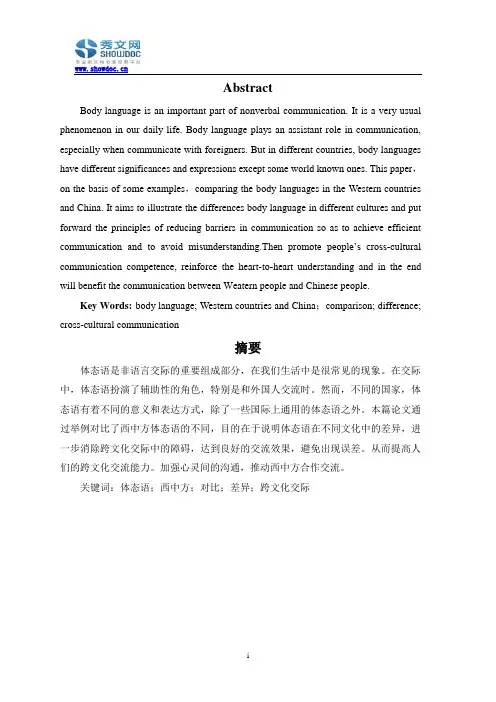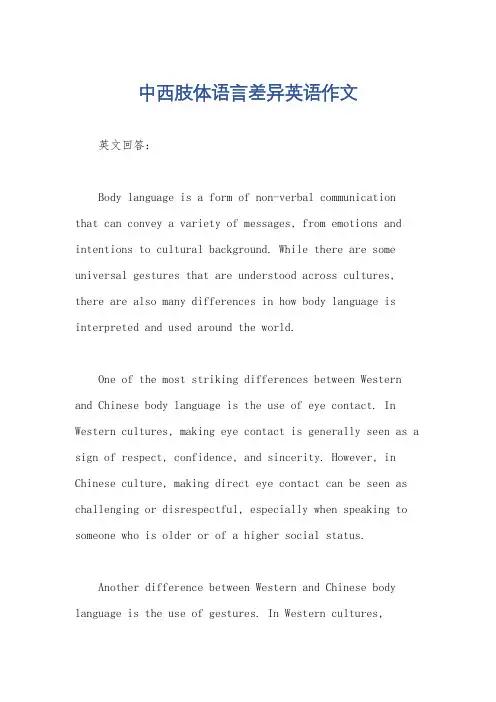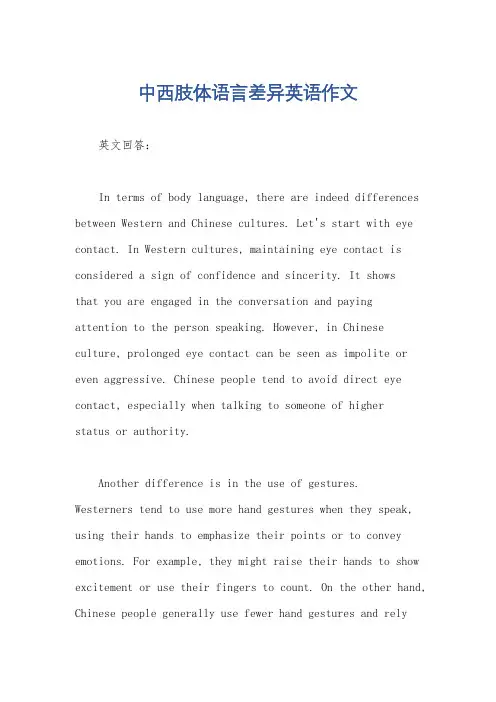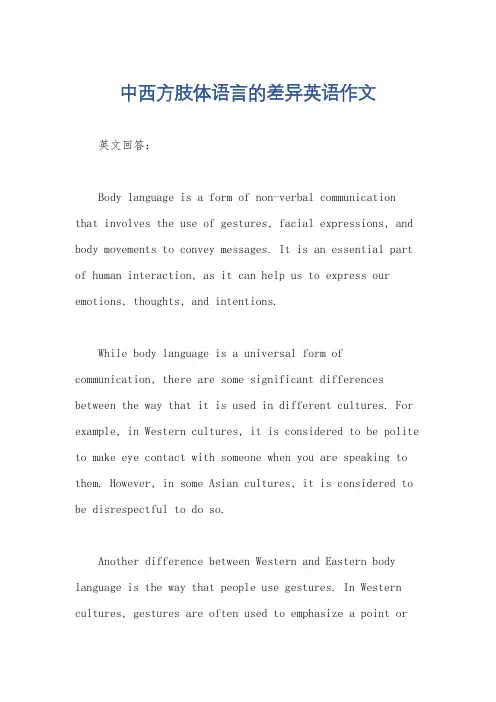中西身势语差异Body Language
- 格式:ppt
- 大小:1.25 MB
- 文档页数:23


跨文化交际视角下的中西方肢体语言差异跨文化交际视角下的中西方肢体语言差异姓名:XX 学院:外国语学院专业:英语年级:2009级学号:XXXXXX摘要肢体语言(body language)又称身势语言,是表示使用身体运动或动作来代替或辅助声音、口头言语或其他交流方式进行交流的一种方式的一个术语。
其之所以能够被称之为语言,主要在于它的信息通报性。
肢体语言和我们所学习的语言一样,它作为一种特殊的语言也是不可被忽视的文化的一部分。
它之所以具有着不可忽视的作用是因为它能够在学习和运用语言的过程中通过肢体的不同动作把我们想要表达出的话语以及内部实质意义更为深刻鲜明的表现出来,肢体语言能够更好地促进语言的交流,我们都知道,不论是以中国为代表的东方国家还是以欧美为代表的西方国家都有着肢体语言的存在,除了一些世界公认的肢体语言以外,不同的国家肢体语言还有着其不同的语言内涵,了解东西方不同的肢体语言有助于我们更为深入地了解西方文化,更好的增进我们语言的进修。
目录肢体语言的定义,重要性Ⅱ肢体语言的分类A :表情语言B :动作语言C : 体态语言Ⅲ影响跨文化交流中肢体语言的因素A:语言习惯B: 风俗习惯C:价值观Ⅳ正确理解中西方肢体语言的区别和运用A:动作一样,意义不同B:意义相同,动作有差异C:只存在于美国文化中的动作D:只存在于中国文化中的动作E:对一些常见的肢体语言的理解关键词:肢体语言、跨文化交际、如何运用正文Ⅰ肢体语言的定义,重要性肢体语言(body language)也称体态语言,是人类借助和利用自己的面部表情、手势动作、身体姿态的变化来表达和传递思想感情的方式。
运用自己的体态来表情达意几乎是人类自身的一种本能,因为它简便、迅捷、直观,在现实生活中的使用极其广泛,而且有时更能无声胜有声地巧妙表达信息并留给对方更大的想象空间。
Ⅱ肢体语言的分类1.面部表情语言(facial expression language)在跨文化交流中,面部表情语言指的是在交流的过程中通过面部的一系列动作,来传达出我们内心的真实想法,不同国家的人民之间存在着语言障碍,但是通过面部的千变万化的表情我们可以相互了解对方的意愿,他的喜、怒、哀、乐,悲、恐、惊。

AbstractBody language is an important part of nonverbal communication. It is a very usual phenomenon in our daily life. Body language plays an assistant role in communication, especially when communicate with foreigners. But in different countries, body languages have different significances and expressions except some world known ones. This paper,on the basis of some examples,comparing the body languages in the Western countries and China. It aims to illustrate the differences body language in different cultures and put forward the principles of reducing barriers in communication so as to achieve efficient communication and to avoid misunderstanding.Then promote people’s cross-cultural communication competence, reinforce the heart-to-heart understanding and in the end will benefit the communication between Weatern people and Chinese people.Key Words:body language; Western countries and China;comparison; difference; cross-cultural communication摘要体态语是非语言交际的重要组成部分,在我们生活中是很常见的现象。

中西肢体语言差异英语作文英文回答:Body language is a form of non-verbal communicationthat can convey a variety of messages, from emotions and intentions to cultural background. While there are some universal gestures that are understood across cultures, there are also many differences in how body language is interpreted and used around the world.One of the most striking differences between Western and Chinese body language is the use of eye contact. In Western cultures, making eye contact is generally seen as a sign of respect, confidence, and sincerity. However, in Chinese culture, making direct eye contact can be seen as challenging or disrespectful, especially when speaking to someone who is older or of a higher social status.Another difference between Western and Chinese body language is the use of gestures. In Western cultures,people often use gestures to emphasize their words or to convey emotions. However, in Chinese culture, gestures are often more subtle and reserved. For example, while Westerners might use a thumbs-up gesture to indicate approval, Chinese people might use a nod of the head or a slight smile.The use of personal space is also different between Western and Chinese cultures. In Western cultures, people tend to value personal space and may feel uncomfortable if someone stands too close. However, in Chinese culture, people are more accustomed to close physical contact and may not be offended if someone stands close to them.These are just a few of the many differences between Western and Chinese body language. By understanding these differences, we can avoid misunderstandings and communicate more effectively with people from different cultures.中文回答:肢体语言是一种非语言沟通形式,可以传递各种信息,从情感和意图到文化背景。

中西肢体语言差异英语作文英文回答:In terms of body language, there are indeed differences between Western and Chinese cultures. Let's start with eye contact. In Western cultures, maintaining eye contact is considered a sign of confidence and sincerity. It showsthat you are engaged in the conversation and payingattention to the person speaking. However, in Chinese culture, prolonged eye contact can be seen as impolite or even aggressive. Chinese people tend to avoid direct eye contact, especially when talking to someone of higherstatus or authority.Another difference is in the use of gestures. Westerners tend to use more hand gestures when they speak, using their hands to emphasize their points or to convey emotions. For example, they might raise their hands to show excitement or use their fingers to count. On the other hand, Chinese people generally use fewer hand gestures and relymore on facial expressions and body movements. They might nod or shake their heads to indicate agreement or disagreement, or use subtle movements of the hands to convey meaning.Furthermore, personal space is another aspect where differences can be observed. In Western cultures, people tend to have a larger personal space and value their privacy. They prefer to keep a certain distance when interacting with others, especially with strangers. On the contrary, in Chinese culture, personal space is much smaller and people are accustomed to being in close proximity to others. It is common to see people standing close together or even touching when having a conversation.Lastly, let's talk about the use of touch. In Western cultures, physical touch is more common and acceptable. It is not uncommon to see friends hugging or patting each other on the back as a form of greeting or showing affection. However, in Chinese culture, physical touch is generally reserved for close family members or intimate friends. Public displays of affection, such as hugging orkissing, are not common and may be seen as inappropriate or even offensive.中文回答:在肢体语言方面,西方文化和中国文化确实存在差异。

跨文化交际视角下的中西方肢体语言差异姓名:XX 学院:外国语学院专业:英语年级:2009级学号:XXXXXX摘要肢体语言(body language)又称身势语言,是表示使用身体运动或动作来代替或辅助声音、口头言语或其他交流方式进行交流的一种方式的一个术语。
其之所以能够被称之为语言,主要在于它的信息通报性。
肢体语言和我们所学习的语言一样,它作为一种特殊的语言也是不可被忽视的文化的一部分。
它之所以具有着不可忽视的作用是因为它能够在学习和运用语言的过程中通过肢体的不同动作把我们想要表达出的话语以及内部实质意义更为深刻鲜明的表现出来,肢体语言能够更好地促进语言的交流,我们都知道,不论是以中国为代表的东方国家还是以欧美为代表的西方国家都有着肢体语言的存在,除了一些世界公认的肢体语言以外,不同的国家肢体语言还有着其不同的语言内涵,了解东西方不同的肢体语言有助于我们更为深入地了解西方文化,更好的增进我们语言的进修。
目录肢体语言的定义,重要性Ⅱ肢体语言的分类A :表情语言B :动作语言C : 体态语言Ⅲ影响跨文化交流中肢体语言的因素A:语言习惯B: 风俗习惯C:价值观Ⅳ正确理解中西方肢体语言的区别和运用A:动作一样,意义不同B:意义相同,动作有差异C:只存在于美国文化中的动作D:只存在于中国文化中的动作E:对一些常见的肢体语言的理解关键词:肢体语言、跨文化交际、如何运用正文Ⅰ肢体语言的定义,重要性肢体语言 (body language)也称体态语言,是人类借助和利用自己的面部表情、手势动作、身体姿态的变化来表达和传递思想感情的方式。
运用自己的体态来表情达意几乎是人类自身的一种本能,因为它简便、迅捷、直观,在现实生活中的使用极其广泛,而且有时更能无声胜有声地巧妙表达信息并留给对方更大的想象空间。
Ⅱ肢体语言的分类1.面部表情语言(facial expression language)在跨文化交流中,面部表情语言指的是在交流的过程中通过面部的一系列动作,来传达出我们内心的真实想法,不同国家的人民之间存在着语言障碍,但是通过面部的千变万化的表情我们可以相互了解对方的意愿,他的喜、怒、哀、乐,悲、恐、惊。


中西方肢体语言的差异英语作文英文回答:Body language is a form of non-verbal communicationthat involves the use of gestures, facial expressions, and body movements to convey messages. It is an essential part of human interaction, as it can help us to express our emotions, thoughts, and intentions.While body language is a universal form of communication, there are some significant differences between the way that it is used in different cultures. For example, in Western cultures, it is considered to be polite to make eye contact with someone when you are speaking to them. However, in some Asian cultures, it is considered to be disrespectful to do so.Another difference between Western and Eastern body language is the way that people use gestures. In Western cultures, gestures are often used to emphasize a point orto convey a specific message. However, in some Eastern cultures, gestures are used more sparingly and are often considered to be more subtle.Finally, there are also differences in the way that people use body language to express emotions. In Western cultures, it is common to express emotions openly and directly. However, in some Eastern cultures, it is considered to be more appropriate to express emotions indirectly or subtly.These are just a few of the many differences between Western and Eastern body language. It is important to be aware of these differences when interacting with people from other cultures, as it can help to avoid misunderstandings and miscommunications.中文回答:肢体语言是一种非语言交流形式,它涉及使用手势、面部表情和身体动作来传达信息。

各国身势语的讲座英语作文英文回答:Body language varies greatly across different countries, and understanding these differences is crucial foreffective communication. In this essay, I will discuss the significance of body language in various cultures and provide examples to illustrate my points.In many Western countries, such as the United Statesand the United Kingdom, eye contact is considered a sign of respect and attentiveness. When engaging in conversation, maintaining eye contact shows that you are activelylistening and interested in what the other person is saying. However, in some Asian cultures, such as Japan and China, prolonged eye contact can be seen as a sign of disrespector aggression. In these countries, it is more common to lower one's gaze as a sign of respect.Another example of cultural differences in bodylanguage can be seen in the use of hand gestures. In Italy, for instance, people are known for their expressive hand movements. Italians often use gestures to emphasize their points or to convey emotions. This is quite different from countries like Japan, where hand gestures are less common and considered more reserved. In Japan, it is important to be mindful of using minimal hand movements during conversations.Furthermore, the meaning of a smile can vary across cultures. In Western cultures, a smile is often seen as a sign of happiness or friendliness. However, in some Eastern cultures, such as Russia or Korea, a smile can be interpreted as a sign of suspicion or insincerity. It is important to be aware of these cultural differences to avoid misunderstandings or unintended offense.Additionally, the concept of personal space differs from culture to culture. In many Western countries, people value their personal space and prefer to maintain a certain distance when interacting with others. On the other hand,in countries like Brazil or Italy, people tend to standcloser to each other and have a smaller personal space. This difference in personal space can sometimes lead to discomfort or misunderstanding if not taken into consideration.To summarize, body language plays a significant role in intercultural communication. Understanding and adapting to the body language norms of different cultures can greatly enhance our ability to connect and communicate effectively. By being aware of the cultural nuances in eye contact, hand gestures, smiles, and personal space, we can avoid misunderstandings and build stronger relationships.中文回答:不同国家的身势语差异很大,了解这些差异对于有效的沟通至关重要。


中西肢体语言差异英语作文Differences in Body Language between Chinese and Western Cultures.Body language, often referred to as nonverbal communication, plays a crucial role in interpersonal interactions. It involves the use of gestures, facial expressions, eye contact, posture, and spatial relations to convey messages and emotions. In China and Western cultures, body language differs significantly, reflecting the unique values, traditions, and social norms of each society. This essay explores the distinctive features of body language in Chinese and Western cultures and highlights the underlying reasons for these differences.In Chinese culture, body language tends to be moresubtle and contextual. Gestures are often made with a sense of modesty and reserve, reflecting the Chinese value of humility. For instance, when greeting someone, a Chinese person might bow their head slightly or nod politely,rather than embrace or shake hands as is common in Western cultures. This behavior is a testament to the Chinese emphasis on politeness and respect for authority.Facial expressions in Chinese culture are also rich in nuance. The eyes, in particular, are considered a window to the soul. Chinese people often communicate their thoughts and feelings through subtle changes in their eye gaze and facial expressions. A smile, for instance, can range from a polite greeting to a sincere expression of joy, depending on the context and the intensity of the expression.By contrast, Western body language tends to be more direct and expressive. Westerners often use more gestures and facial expressions to communicate their thoughts and emotions. Shaking hands is a common greeting practice in many Western countries, reflecting a culture of equality and friendliness. Westerners also tend to use more eye contact, which is often interpreted as a sign of sincerity and confidence.Posture and spatial relations also differ betweenChinese and Western cultures. In China, maintaining a low profile and avoiding conflict is highly valued. This is reflected in the posture of Chinese people, who often stand or sit with their backs straight but heads slightly bowed. In contrast, Westerners tend to adopt a more upright posture, reflecting their culture's emphasis onindividuality and assertiveness.Spatial relations are also differently interpreted in the two cultures. Chinese culture values harmony and close-knit communities, and therefore, personal space is often considered less important than in Western cultures. By contrast, Westerners tend to value privacy and personal space more highly, and they may find Chinese proximity and touching behaviors intrusive.The underlying reasons for these differences can be traced to the distinct historical, social, and cultural backgrounds of Chinese and Western cultures. Chinese culture, influenced by Confucianism and Taoism, emphasizes harmony, respect for authority, and modesty. These values shape the subtle and contextual nature of Chinese bodylanguage. By contrast, Western culture, influenced by Greco-Roman traditions and the Enlightenment, values individuality, freedom, and directness, which is reflected in the expressive and direct nature of Western body language.In conclusion, the differences in body language between Chinese and Western cultures reflect the unique values, traditions, and social norms of each society. Understanding these differences is crucial for effective cross-cultural communication and promoting mutual understanding and respect between people from different cultures. By embracing and adapting to these differences, we can build bridges of understanding and friendship across cultural divides.。
走进Body Language 感悟中外文化差异高一(14)班英语研究性学习小组【简介】本文通过网络搜索、查阅书面资料及电子文档、小组分工合作讨论、问卷调查等形式,结合英语与历史学科的特点,对世界各国的肢体语言进行了一系列探讨。
在研究中从多方面对肢体语言进行了学习,增加对肢体语言认知,提高对英语的兴趣,并了解肢体语言在不同文化背景下的不同的含义与社会功能,使我们在人际交往中能够成功地进行交流。
【关键词】中外文化差异人际交往社会功能一、摘要Body Language肢体语言,又称为身势语言,是表示使用身体运动或动作来代替或辅助声音、口头言语或其他交流方式进行交流的一种方式的一个术语。
它是副语言(Paralanguage)的一种类型,副语言包括各种形式的非口头语言的人类交流方式,包括不为人注意的最细微的动作,例如眨眼和眉毛的轻微运动。
肢体语言可以与面部表情结合使用。
(又叫肢体语言,是由人的四肢运动引起的,也可以传递许多信息。
握手是身体语言中最常见的一种。
)世界各国的肢体语言与语言和文化一样,也有相似之处。
然而,由于地域,种族,文化习俗的差异,不同文化的肢体语言有许多差异。
它们由文化制约并拥有独特的文化内涵。
二、研究过程1.开题报告(1)过程::①我们先询问老师开题报告的填写要点。
②小组成员各自谈谈对课题的理解。
③经过一番讨论后,确立了课题研究重点。
(肢体语言在不同文化下的差异)④顺利地完成了开题报告的填写。
(2)内容:班级:高一14班指导老师:黄玉霞课题组成员:陈嘉淼、魏燕敏、洪舜熠、林宇琳、曾乐佳、邱瑞玲、李芸、陈婧主要课程:英语相关课程:历史,电脑,数学研究时间: 2012.02~2012.05研究的主要方法:上网查阅资料,咨询老师,上书店查阅资料研究计划:<1>任务分工:①制定计划,研究方案④设计、统计调查问卷②收集资料(文字、图片等)⑤撰写开、结题报告③整理分析资料⑥撰写论文,活动报告<2>研究步骤:第一阶段:充分准备、制定计划第二阶段:写开题报告,收集资料第三阶段:设计调查问卷第四阶段:统计调查结果,整理分析资料第五阶段:模拟情景,学习肢体语言第六阶段:撰写论文、结题报告可行性分析:我们对该课题充满浓厚的兴趣,可运用课余时间多方面了解本课题所涉及的相关知识。
知识拓展:肢体语言与中西方文化差异肢体语言(body language)是指能够传递某种特定信息的面部表情、手势语,以及其他身体部位的动作等等。
它在人际交往过程中起着非常重要的作用。
由于社会的发展,国与国之间的交流不断加强,西方的许多肢体语言在我国也已经被认同,还有一些被普遍适用。
比如:西方人往往指胸口来表示“我”。
大拇指朝上,表示“好”;但大拇指朝下则表示“坏,糟透了”。
还有用大拇指指尖与食指指尖相接成O形,伸直其余三个指头,表示OK,即“正常”、“顺利”、“没问题”。
伸出食指和中指成V形,表示victory(胜利)。
如果招手示意别人过来,他们是伸出掌心朝上,捏拢四指,前后弯动食指。
当然,在中国和西方国家中,肢体语言其含义也存在不同程度上的差异。
不过,很多肢体语言表达的含义还是一致的,比如,点头表示:同意或者表示明白了,听懂了;眉毛上扬表示:不相信或惊讶;避免目光接触意味着:冷漠,逃避,不关心,没有安全感,消极,恐惧或紧张等;摇头表示:不同意;鼓掌:赞成或高兴等等,但是在这里,我们主要通过分类来说明,在不同的文化背景下,不同的肢体语言在不同程度上所存在的差异,了解从中体现出来的文化差异,从而提高我们学习语言的兴趣。
一、动作一样,意义不同(the same action,different meaning)。
如下例:1. 跺脚(stamp one’s foot):在中国人看来,表示气愤,恼怒,灰心,悔恨。
比如说:气得直跺脚。
而它的英文含义则是不耐烦,比如:give a stamp of impatience(不耐烦得跺脚)。
2. 目不转睛地看(look with fixed gaze):其中文含义是:好奇;有时是惊讶。
比如,孩子们目不转睛地盯着公园里的猴子;他目不转睛的看着科幻书上的飞碟等等。
而这个短语的英文含义则是不礼貌;使人发窘;不自在。
比如:Under his intense gaze she felt uncomfortable.(他目不转睛地看着她,使她觉得很不自在。